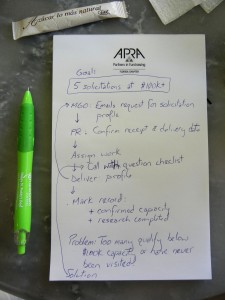Whether you work in a large office or are a solo researcher, a process for managing research requests quickly becomes important if you expect to use your time efficiently.
I’m talking about a process, not a form, for managing requests, because many offices have quite happily and successfully abandoned the notion of a form to ensure human interaction for better communication.
Besides, discussing the process allows you to piece together a system that works best for you, your team, and your organization. Discussing the process does not give you the exact steps you should take in your office, but that’s research, right?
There is rarely a predetermined path to answer a question, but there’s a method. Research is not a model airplane kit; it’s a bucket full of building blocks with some suggested projects.
I recommend creating a list of the types of research requests you receive. It might look something like this:
- Qualification and Solicitation Profiles
- New prospect identification
- Suggested prospect assignments and prospect management reporting

Now build a flow chart for each request type. It could be a more graphical visual or like the list pictured, but it disciplines you to think through the process. Get as detailed as is helpful. By documenting the process you can identify where you might alter it to solve a problem.
Why not create a flow chart that starts with the fundraising goal the task supports? This will help everyone on the team recognize that you are not in charge of managing the printer, but of managing critical information that will help reach the goal.
Following are three really good reasons to create a process for managing your research requests:
1. Consistent communication produces consistent behaviors.
Let’s face it. Many frontline fundraisers have never worked with a professional researcher before. Myths abound. If you want consistent behaviors from fundraisers, like providing you with complete information on a prospect, you need to consistently communicate.
Following are some ideas:
- Create standard profile types that include items the fundraiser has identified as most important for common scenarios. Then create the request form with those standard options, but also a place for the fundraiser’s specific needs and anything that helps you better prioritize your time on the request, such as “Yes or No. I anticipate asking this prospect for a major gift this year”. It doesn’t matter if the fundraiser ever knows the form exists. It helps you remember what to ask.
- Create the expectation that you will call before doing the work to ask additional questions. Be sure you call and ask additional questions, which could be on your request form. Before long the fundraiser might begin providing the answers before you ask!
- Make a habit of under-promising and over-delivering. If you want the fundraiser to trust that you will get the work done on time, set your standard turnaround time so that you can deliver at least a day early. Call immediately if you expect to be delayed.
2. Measuring outcomes requires good tracking.
Your process needs to include more than receiving a request and delivering the work. What are your key performance goals? How are you providing value to the fundraising effort?
Following are some scenarios:
- Does your CEO insist on in-depth profiles for every name that crosses her desk? Go ahead and do them, but mark the record with an action of “Profile completed” so you can pull a report that tells you total giving for each person you researched. Now at the end of the year you can present your CEO with how much money it cost (your time, subscription resources, etc.) and how much was raised as a result. Effective? Or time for a change?
- You may be tasked with identifying and qualifying prospects for a campaign. Tag the records that were identified and your capacity rating so you can pull reports throughout the campaign to see how many of those prospects turned into donors. Make sure leadership knows without you those dollars would not have been received!
- You know you are identifying high-capacity prospects with affinity, but the fundraisers won’t visit them. Sit down with the most ambitious, successful fundraiser. Review the capacity ratings of her prospects. Demonstrate how she could raise so much more with the new high-capacity prospects you identified. Then track her progress so she can share her secret to success (you, of course!) with the rest of the team.
3. Documentation gives you the ability to work faster and smarter.
It takes time to document your work and to track information as described above. Researchers do it (and often love it) because documentation allows us and our organizations to achieve more.
I may spend a week keeping a detailed time log to discover just how long it really does take me to perform a specific research task and how much time I spend on administrative trivia. And now when I get a flood of requests, based on my documentation I know how much I need to outsource.
Following are some typical types of documentation:
- Cheat Sheets on how to do advanced functions in research subscriptions – because you might not use those functions every day, but they are powerful when you need them.
- Reasoning and steps behind your most-used database reports – because when your reports require changes, you don’t want to have to start from scratch.
- Reasoning and steps behind the way you record your researched information in the database – because you need to be consistent if you expect to do any automatic reporting.
Communicating consistently, thinking about the outcomes first and documenting tasks underpin a smooth and successful research request process.
Do you have a specific question or some great advice for researchers looking to implement or improve their request process? Please share!
Other Resources You Might Like
Three Reasons Why Research Request Forms Are a Terrible Idea
List of Prospect Research Blogs
Assert Yourself, post by Preeti Gill